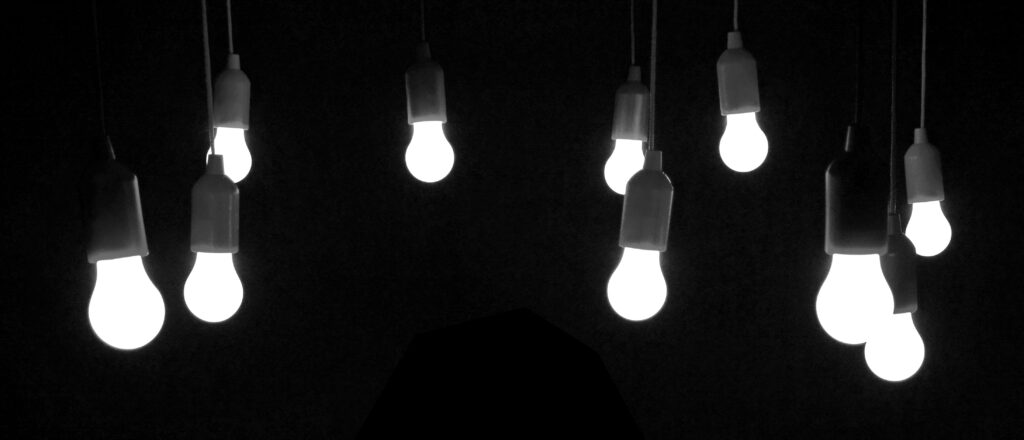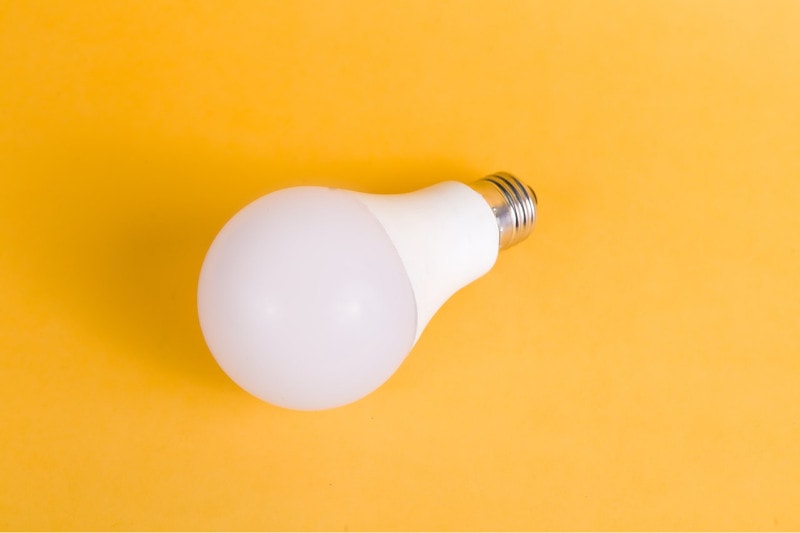How Do LED Lights Work? The Interesting Answer!
-

- Last updated:

If you’ve walked down the light aisle at the store lately, you’ve seen a ton of LED bulbs. But you’ve also likely noticed that they cost a bit more than the other options.
How do LED lights work, why do they cost more, and are they worth the extra money? There are some interesting questions to answer, but if you’re looking to save money in the long run, LED lights are clearly the way to go.
They work in a more efficient manner than other bulbs, and they have even more perks because of their unique internal structure. We’ll break it all down for you here.

How Does It Work?
LED stands for “light emitting diode,” and they’re far more efficient than traditional incandescent bulbs. LED lights work by sending an electrical current through a microchip. The microchip directs electricity to the small LED bulbs which causes them to light up.
This happens as electrons in a semiconductor material emit photos through electroluminescence. Electroluminescence is a scientific principle and phenomenon where excited electrons release energy as photons.
It’s a bunch of complicated scientific principles, but the end result is an extremely efficient and durable process that can produce large amounts of light. There’s no filament in LEDs, which is how incandescent bulbs work.
By ditching the filament, LEDs produce far less heat, which is a waste of energy. Instead, an LED can produce more light with less energy!

What Are the Different Types of LED Lights?
While LED lights all work with the same principles, there are a lot of different ways manufacturers can tweak the bulbs to achieve different effects. From the intensity of the light to the shape of the bulb, there are a lot of different options.
First, there are LEDs with variable intensities and color-changing technologies. These lights work great as mood setters or as a festive way to decorate a different space. But for bulbs without the ability to change color intensity or colors, there are LED bulbs with different color temperatures. This can help create a cozier ambiance in living spaces or a more productive and bright space for offices.
Finally, there is a big difference in the size and shape of different LED bulbs. There are small LEDs that fit on a light strip, and there are LEDs inside traditional incandescent glass bulbs. These bulbs work for different settings, and despite their different shapes and sizes, they work in the same way.
Still, the traditional bulb styles will fit into regular light fixtures, while traditional LED strips and string lights typically go into 120-volt outlets. But because of how energy-efficient LED bulbs are you can even find LED lights that plug into 12-volt outlets inside cars that produce a ton of light.

Where Is It Used?
Because of how efficient and versatile LED bulbs are, you can find them just about anywhere. They’re now commonplace in cars and homes, and they’re rapidly replacing typical incandescent and halogen bulbs.
In fact, on August 1, 2023, the United States is completely phasing out many non-energy efficient incandescent and halogen bulbs. The United States won’t fully transition to LED bulbs, but they will likely make up far more of the market share.
Today, LED bulbs can do everything a halogen and incandescent bulb can do, and because of how much more efficient and longer lasting they are, they’re an outstanding choice for your home, car, and office. If you’re shopping for a new light and see an LED, it’s probably the better long-term deal.

Advantages of LED Lights
There are quite a few advantages of LED lights compared to other options. First, LED lights don’t produce nearly as much heat. This makes them safer than other bulbs. They also last far longer. With the average incandescent and halogen bulb not making it more than 2,000 hours, the fact that an LED can last up to 50,000 hours is a big deal.
Another advantage is that LEDs cost far less to run compared to incandescent and halogen bulbs. That’s because LED lights are more efficient, so they don’t need to waste as much energy to light up. This might not seem like a big deal, but it makes a big difference.
Regular bulbs typically require five times as much energy to run, which means you’re spending five times as much to get the necessary electricity.
Disadvantages of LED Lights
While there are tons of advantages to LED bulbs, one major disadvantage is their upfront cost. LED bulbs cost more to produce than other types of bulbs, which drives up the initial sale price.
However, because of the lower cost to run LED bulbs and how much longer they last, they still have a lower cost over their entire lifespan than other bulb options. But there’s no denying you’ll spend a little more at the store when it’s time to replace them!

Frequently Asked Questions (FAQs)
LED lights work in a completely different way than other light sources, and this makes it perfectly normal to have a few questions. We understand, and it’s why we decided to answer some of the most frequently asked questions for you here.
Can You Leave LED Lights on All Night?
Yes! Unlike other types of lights that generate a ton of heat, LED lights don’t produce any heat. This makes them perfectly safe to run day and night every day of the week all year long!
Do LED Lights Attract Bugs?
LED lights don’t emit UV light or heat, which means very few insects come to check them out. If you’re putting LED lights out on a porch or patio, you will get far fewer bugs than with other bulbs.

Can You Leave LED Lights Out in Winter?
Yes! LED bulbs have no problem dealing with different temperature changes. They also don’t generate a ton of heat, so you don’t have to worry about them creating problems in the colder weather in the same way as other types of bulbs.
How Do LED Lights Wear Out?
While a regular bulb will simply stop working suddenly, that’s not how LED bulbs typically wear out. LED bulbs wear out and dim over time, so you might find you want to replace them before they officially stop working completely.
How Much Does It Cost to Run an LED Light Bulb for 1 Hour?
This question all comes down to the necessary watts to run the bulb and how much you’re paying per watt. As an example, if you’re paying $0.10 per kWh with a 10-watt LED bulb, you’ll pay $0.01 per hour to run it. But for a 60-watt bulb, you’re paying $0.06 per hour!
Overall, you can expect to spend 1/5th of what it would cost to run a non-energy-efficient bulb that produces a comparable amount of light.

A Quick Reference Guide
- Longer lasting
- More energy efficient
- Low heat production
- Better resistance to different temperatures
- Higher initial cost
- Higher cost to replace

Conclusion
LED lights offer a ton of advantages over other types of bulbs, and if you’re picking out different bulbs for your car, home, or office, you really want to consider LEDs.
There’s a reason they’re becoming so much more popular, and the initial price for LEDs is consistently dropping to make them a more affordable upfront choice. If you plan on using the bulb for a while, an LED has a ton of perks and is likely the way to go!
Featured Image Credit: JumpStory
Contents
